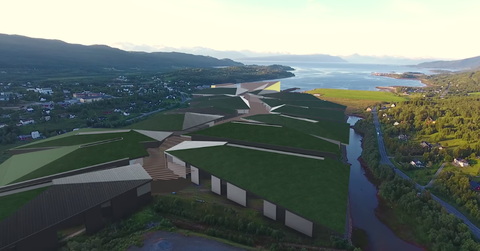World's Largest Data Center Will Be Powered By Renewable Energy
Norway will not only have the world's largest data center, but it's going to be only powered by sustainable sources. Fluent with hydropower in the area, the facility also takes advantage of its cool surroundings to use limited energy.
Updated May 21 2019, 3:51 p.m. ET
Your devices aren’t the only objects using energy when surfing on the internet. Servers packed in data centers require a lot of energy for people to be able to stream their favorite shows and run their upcoming fantasy football draft. Norway will soon hold the largest data center in the world, and it will be run fully on renewable energy.
Kolos, an American-Norwegian company, will be behind the creation of the new data center in collaboration with HDR. It’s in a location that provides the best cooling method for the new data center -- a fjord above the Arctic circle. What is a fjord? A deep entrance to the sea that’s located between high cliffs and is surrounded by land, providing an extremely cool environment for the data center to run.
The data center sits in Ballengen, Norway, at four stories tall 600,000 square meters, and it’s integrated into a beautiful environment surrounded by mountains and water. It’ll be fueled by a neighboring hydropower and will be servicing many areas in Europe and along parts of United States’ East Coast. It’s expected to be running on full power in the next 10 years.
“It’s an honor to be part of such a visionary project,” said Doug Wignall, HDR’s President of Architecture, in a press release. “Kolos has a deep appreciation for design thinking and the power of design to transform the data center sector. With this project they are making a strong statement that in addition to being highly sustainable and technically sophisticated, data centers can also be inspiring pieces of art that are integrated with the community and natural surroundings.”
There’s a number of data centers that have opened among the Scandanavian countries. Two large Facebook companies are located in Sweden and Denmark, two Apple centers are in Denmark alone. All of these data centers can use a whopping 100 to 200 megawatts alone, but at the site where the largest is located at, will feature up to a gigawatt of power usage. Luckily, the local hydropower plant can be scaled up to two gigawatts in the area.
Another unique aspect of the building is its entire design, which HDR compares to “a glacier’s movement.” Data halls are along the center spine and covered with green roofs. Near the water, “the spine emerges as a public element clad in copper, a reference to the area’s copper mining history.” The multiple buildings along the spine are on top of old mines where copper and zinc were farmed out, and this keeps the heritage of the town alive.
Mark Robinson, one of Kolos’ CEOs, explained the design process to Engineering News-Record. Buildings are shaped around the layout of their machinery, and everything is located in a remote section of town that doesn’t bother the residents. “The conical shape we used focuses the sound downward and not into the air. It’s a good sound barrier and would block the noise the data center creates from the residents’ homes.”
Norway’s new data center will open next year. It's both massive and attractive as it meshes well with the community. With so much hydropower available, it has room to expand over many years. It provides a great example on how to build sustainable data centers in the future by taking advantage of the environment surrounding it.
